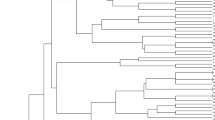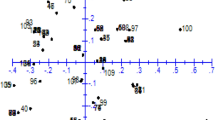Abstract
For studying genetic differentiation caused by selection for adaptation and end-use, the allele frequencies of 42 microsatellites (MS), representative of the three wheat genomes, were analysed in a total of 60 wheat cultivars. The cultivars originate from three agroecological areas (AEAs) – Germany, Austria and Hungary – and represent equal numbers of ’quality wheats’ and ’feed wheats’ for each country. For the 42 loci, 202 alleles were detected using PAGE and silver staining. The average number of alleles per locus was 4.8, including four monomorphic loci. For 16 loci, null alleles were detected. Cluster analysis clearly differentiated the varieties according to the three AEAs and, within each AEA, into quality wheats from feed wheats. Analysis of variance revealed highly significant differences of distance data between AEAs as well as between quality groups. The correlation between genetic distance (GD) and pedigree data (coefficient of diversity, COD) was r s=0.45. The results have proven the excellent resolving power of MS in varietal differentiation, which arises through breeding under specific environmental conditions, and for different end-use.
Similar content being viewed by others
Author information
Authors and Affiliations
Additional information
Received: 15 March 1999 / 17 June 1999
Rights and permissions
About this article
Cite this article
Stachel, M., Lelley, T., Grausgruber, H. et al. Application of microsatellites in wheat (Triticum aestivum L.) for studying genetic differentiation caused by selection for adaptation and use. Theor Appl Genet 100, 242–248 (2000). https://doi.org/10.1007/s001220050032
Issue Date:
DOI: https://doi.org/10.1007/s001220050032




